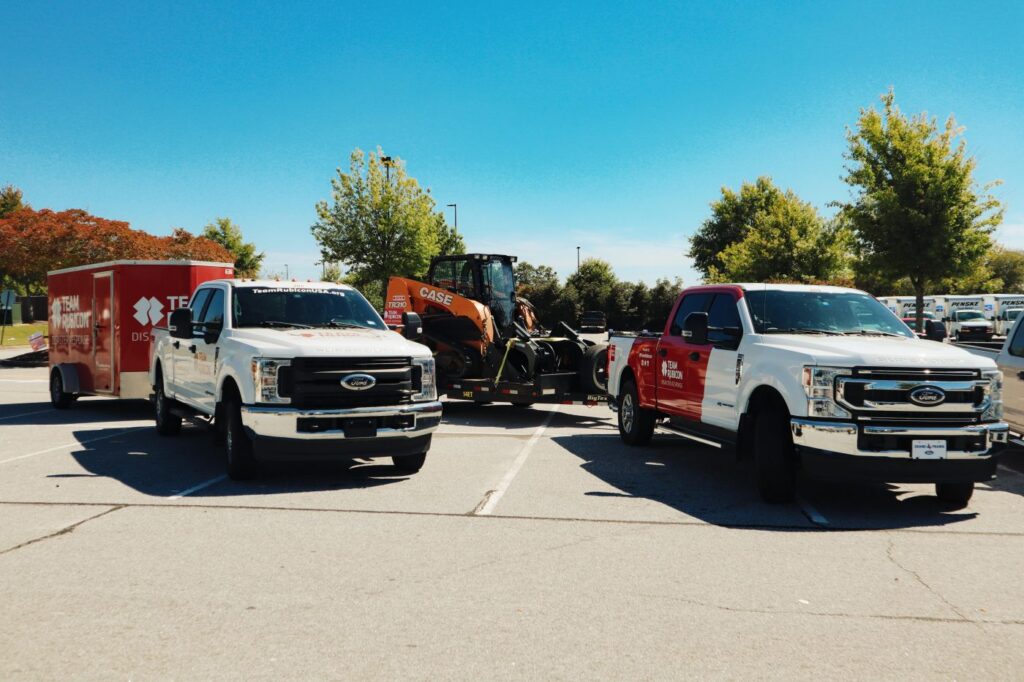When Hurricane Ida plowed through the Gulf Coast as a Category 4 Hurricane, it caused more than $55 billion in damage in Louisiana alone. It also took out power for those in the hardest-hit areas of the state for weeks.
Team Rubicon’s volunteer disaster responders may be accustomed to working in such austere environs, but such austerity doesn’t make getting aid to those affected fast or easy.
Team Rubicon’s Curt Harman was one of the first volunteers to arrive in Louisiana. After assessing the situation on the ground and determining the hardest hit areas most in need of assistance, he set up the Forward Operating Base, or FOB, where volunteers would gather, eat, and sleep, and the Incident Command Center—the nucleus of the operation where leaders would analyze damage, map potential job sites, and plan all the support, tools, and vehicles needed for the coming days—in Houma, LA.

It was hot and humid in Houma as the team prepared for the first wave of Team Rubicon volunteers—or Greyshirts—to arrive to start helping survivors clear out from under the rubble. And yet, they had no electricity. With the power grid down for miles, the Incident Command Center and FOB were running on limited resources.
Then, a Ford F-150 Hybrid with Pro Power Onboard—technology that basically turns an F-150 into a mobile generator—pulled up. Its arrival would mean the difference between days spent on idle or getting out in the field fast. It would also mark a tipping point for how Team Rubicon would conduct initial disaster response in the U.S. in the immediate days after a severe storm.
With the FOB plugged into the F-150, the team was suddenly up and running, powering the kitchen and food prep spaces and all the equipment needed to enable volunteers to make a difference in the affected community. It would run the Incident Command Center—including laptops used to map areas in need of help, cellphones, and comms devices to get volunteers into the field and to job sites. By the next morning, Greyshirts were already out in the disaster zone, helping Hurricane Ida survivors get back into their homes.
It wasn’t the first time we’d had a relationship with Ford. In fact, our relationship with Ford vehicles stretches back at least to Hurricane Harvey, when we began receiving donated vehicles from Team Rubicon’s steadfast donors. Soon, we were also procuring more vehicles of our own—and increasingly betting on Ford. By last year, we had already logged more than 1.49 million miles in Ford vehicles serving communities in need. It was a match made in a sawdust-ed heaven: Ford is built tough, and Team Rubicon is built to serve.
Team Rubicon’s relationship with Ford expanded even further last year when Hurricane Ian hit Florida: As we deployed more than 2,600 Greyshirts to the state, Ford made a $300,000 commitment to fuel our response there. And, this spring, when we deployed to Detroit to serve homeowners affected by 2021’s historic floods, more than three dozen Greyshirts and 34 Ford employees worked together to repair and restore 45 homes. Homes untouched by aid nearly two years after the flood.
Then, on June 20, 2023, our relationship with Ford multiplied exponentially with the announcement of a new partnership: “Team Rubicon Powered by Ford.” With it, the Ford Motor Company Fund will make a $2.5 million philanthropic investment in our disaster relief and humanitarian aid organization, and Ford Motor Company is donating 17 vehicles to enhance our ability to reach communities impacted by the increasing number of natural disasters across the United States.
When the next hurricane hits the U.S. this year, we expect our route clearance teams will be driving Ford F-150 Hybrids with that Pro Power Onboard into the disaster zone. Sure, those F-150s will be there to pull the heavy equipment—like our skid steers and compact track loaders—so we can open up blocked roadways for other first responders. But, we also expect these new vehicles will help us better lodge those initial route clearance teams full of expert sawyers and heavy equipment operators drivers in very austere environments, as well as ensure the comms equipment we use to deploy Greyshirts to job sites stay up and running.
This year too, when we enter a disaster zone with a disrupted electrical grid, our FOBs and Incident Command Centers will be up and operational faster than ever before, meaning our Greyshirts can be out in the field serving survivors sooner, too.
Most of all, though, this partnership will help us get more shit done. More sawing and sweating; more swamping tornado-toppled trees to the curb and stapling tarps to hurricane-tattered roofs; more getting stuff done.
Including in Detroit where, at this very moment, more than 80 Ford employees and Greyshirts are working together to restore another 75-plus homes that were heavily damaged by historic flooding in 2021.
And now, we at Team Rubicon are excited to know that, as a result of this partnership, we’re going to have more power to serve more people in more disaster zones more reliably and better than ever before.
Ford Tough Meets Mission First
Under “Team Rubicon Powered by Ford,” the Ford Motor Company Fund will make a $2.5 million philanthropic investment in Team Rubicon, and Ford Motor Company will donate 17 vehicles—and 5 years of service and maintenance—to our veteran-led disaster relief nonprofit, including:
10 F-150 Power Boost Hybrid trucks
3 F-150 Lightning trucks
2 Super Duty trucks
2 Bronco SUV



